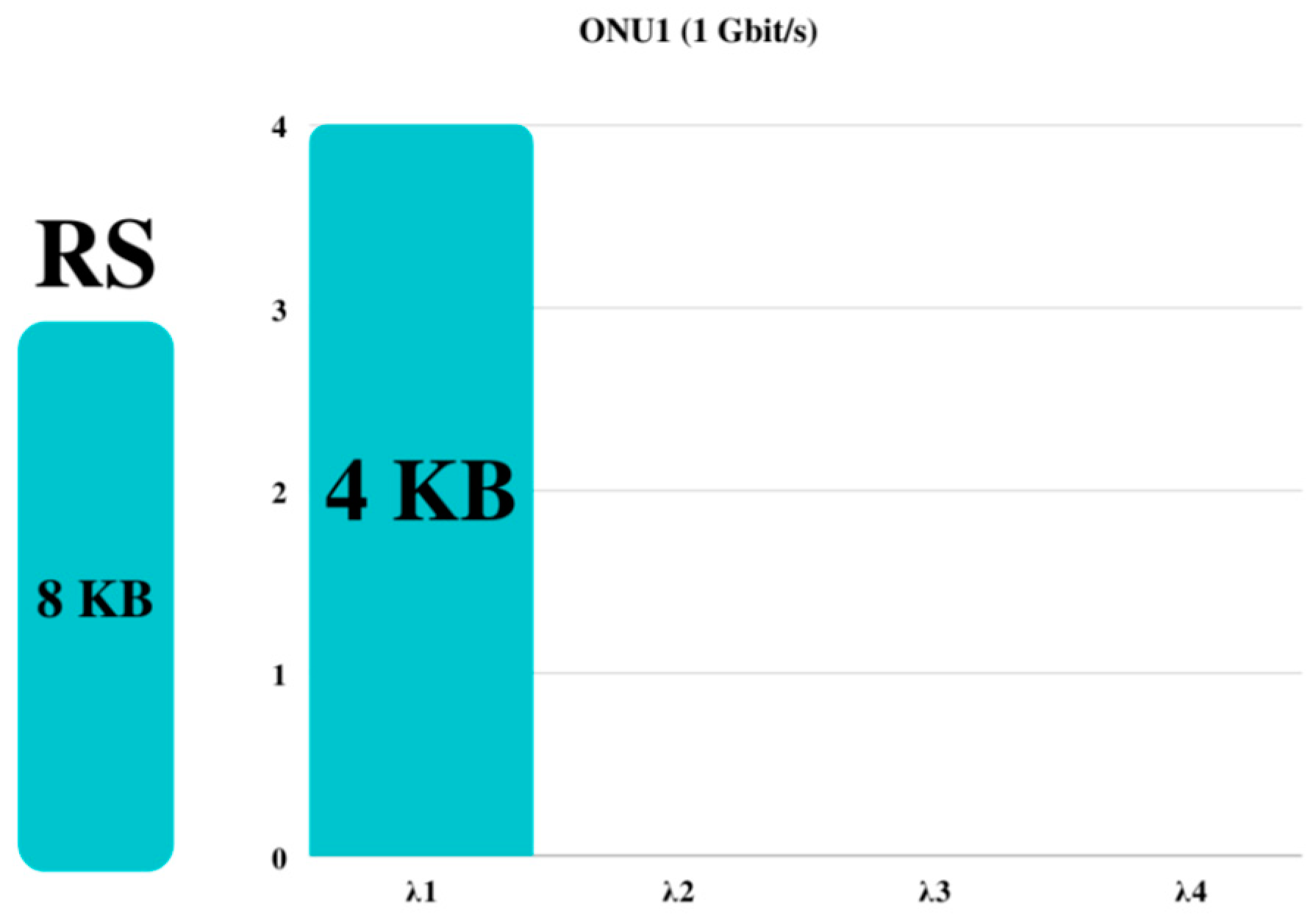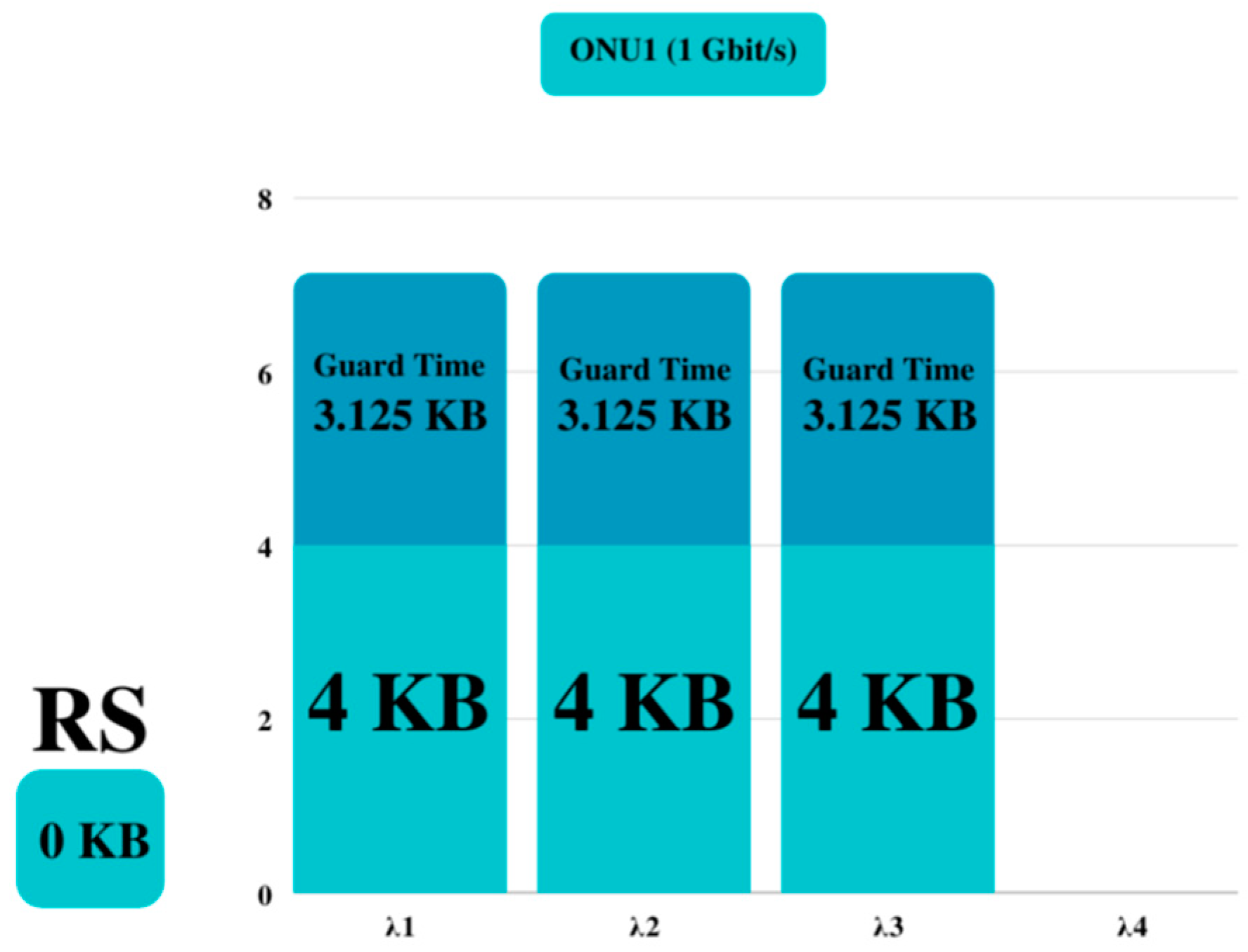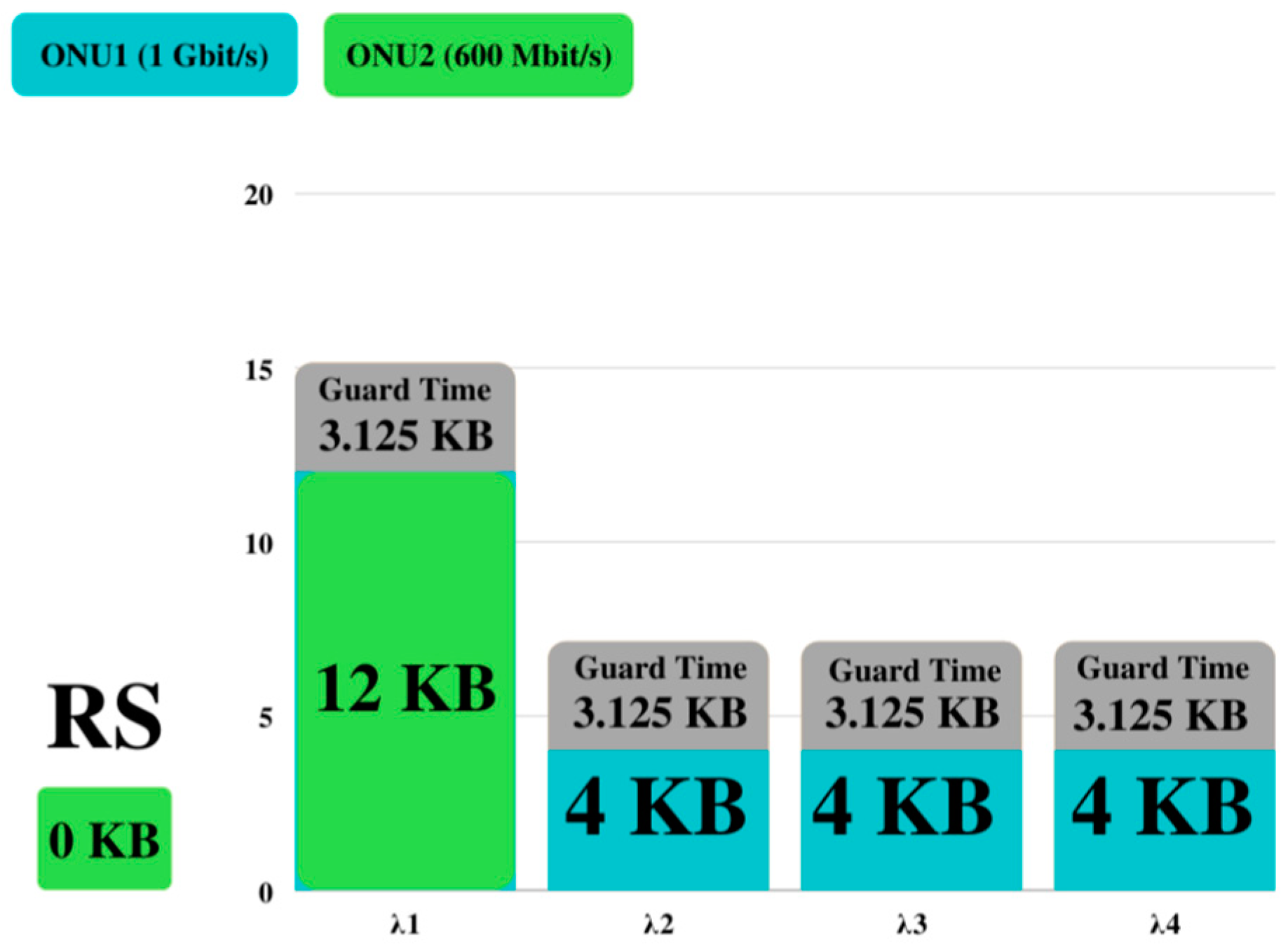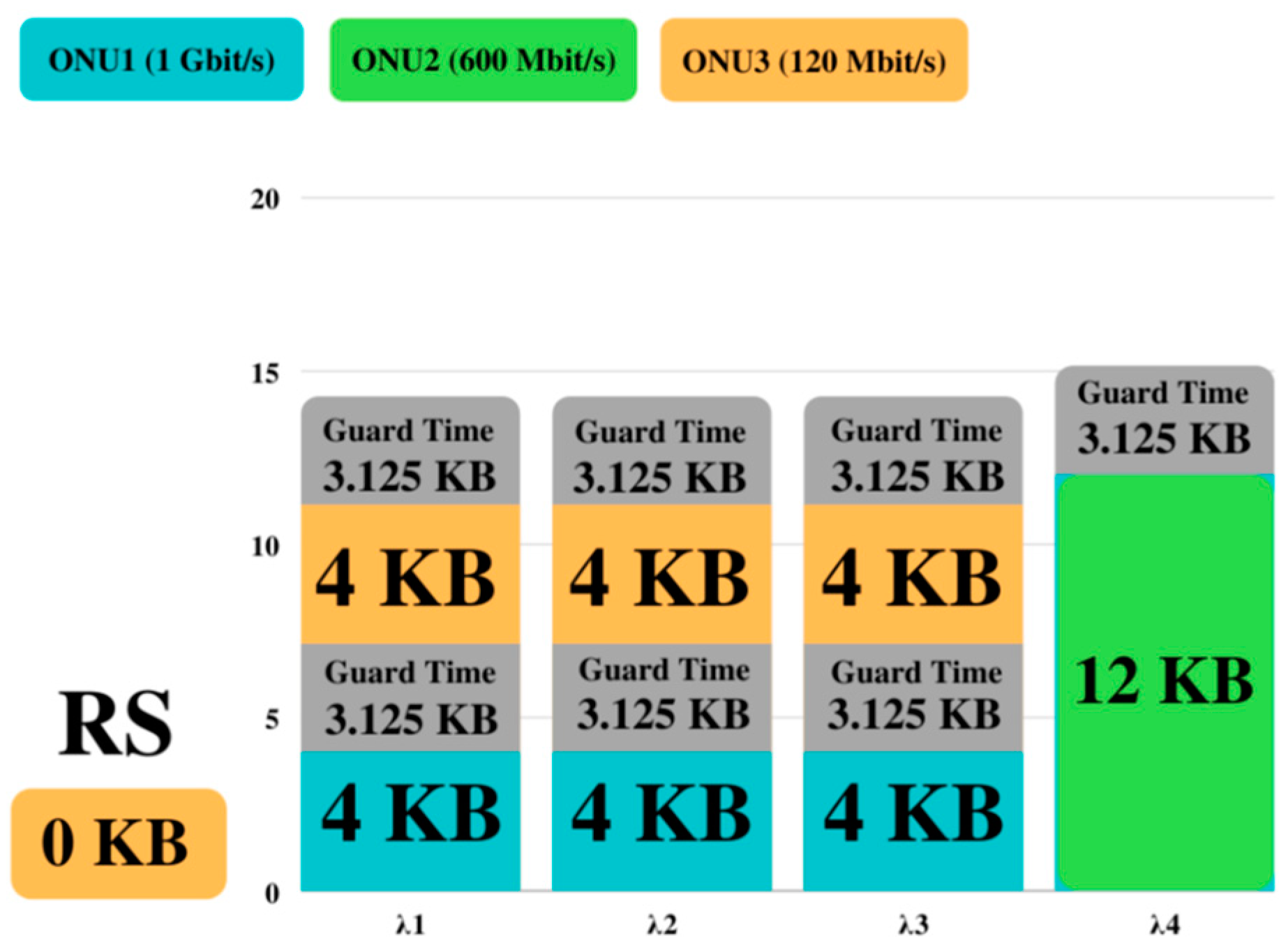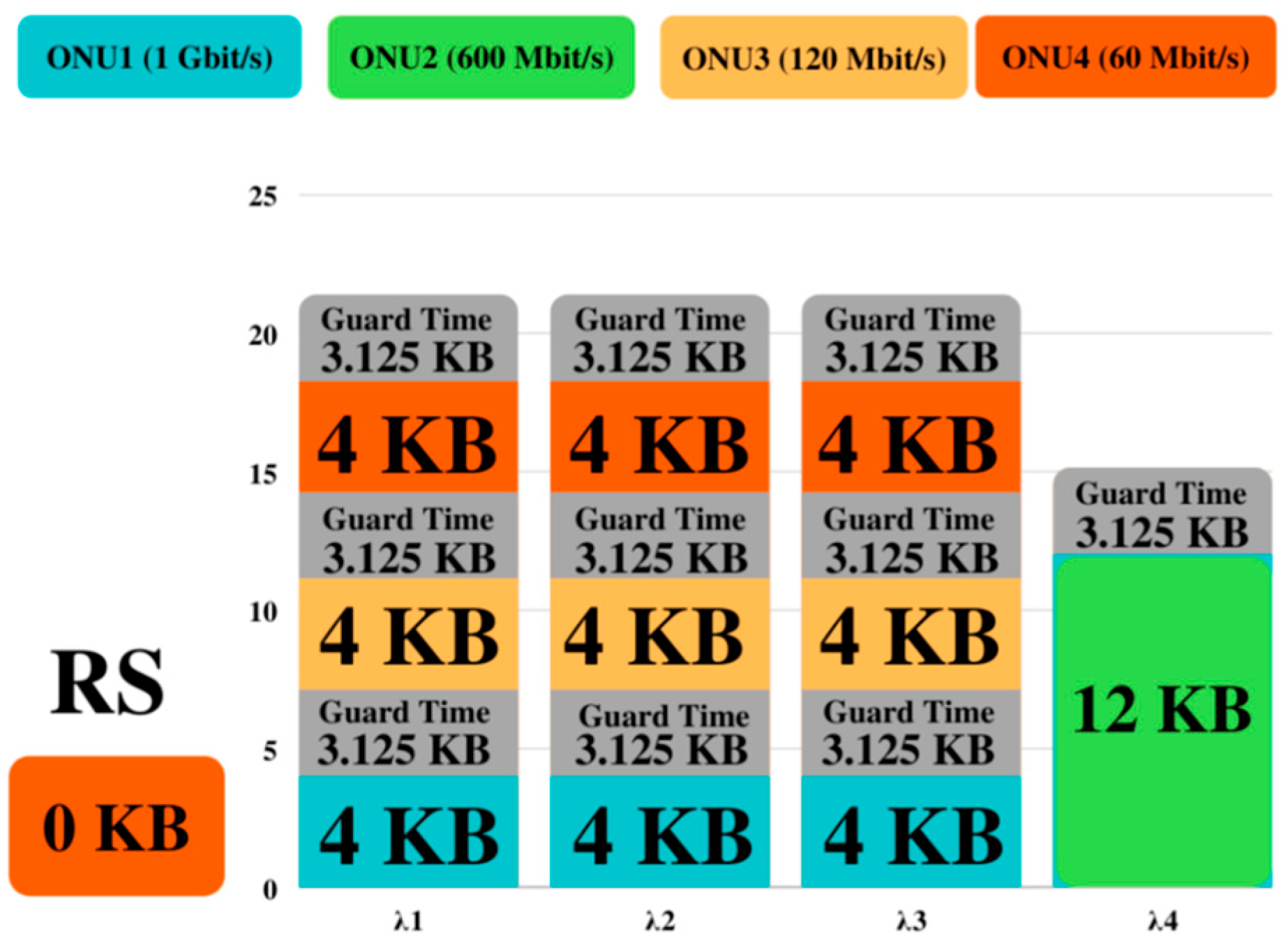1. Introduction
Demands for high-speed data services and bandwidth applications in business and residual customers are continuously rising every day. Due to coverage potential, cost-efficiency and a high transmission capacity, passive optical technologies are becoming a suitable access network option. Future metropolitan and access networks based on optical fiber technologies must keep capital and operational expenditures as low as possible and provide significantly high transmission capabilities per customer. Therefore, a deployment of the Dense Wavelength Division Multiplexing (DWDM) technique is becoming a reality in future Passive Optical Networks (PON) with its extensive operation in a short time [
1,
2]. So, the research is focused on the DWDM technique and its effective utilization in passive optical systems and networks.
For the achievement of highly efficient bandwidth and wavelength utilization, it is requested to have advanced Dynamic Bandwidth and Wavelength Allocation (DBWA) methods [
3,
4,
5] in the Wavelength Division Multiplexing-based Passive Optical Network (WDM-PON) system [
6,
7,
8] that is incorporated into the F5G architecture. Thanks to wavelength-based optical components, a maximal efficiency of the optical transmission medium utilization can be reached. Therefore, demands of customers for higher transmission capabilities and cost-effective services can be effectively accommodated. Nowadays, several standards for next-generation passive optical networks determine a method of cooperation between various dedicated wavelengths. Moreover, various wavelength transmission channels are available for extended protection schemes in advanced network architectures. For highly efficient bandwidth utilization, extended wavelength allocation methods must be also considered in current and near future hybrid Time- and Wavelength Division Multiplexing-based Passive Optical Network (TWDM-PON) [
9,
10,
11,
12,
13]. Among other things, Next-Generation Passive Optical Networks (NG-PON) [
14,
15,
16,
17] provide cost-efficient traffic protection schemes [
18,
19,
20,
21,
22], whereas fault management is important for uninterrupted internet access services [
23,
24,
25]. Therefore, NG-PON networks must support the end-to-end protection option for use cases if specified reliability requirements based on user profiles are expected. In the context of network traffic analysis, a discovery of appropriate tools for the evaluation of protection schemes considered as a part of the F5G architecture in future metropolitan and access optical networks is necessary [
26,
27,
28].
The recent standard for NG-PON2 networks [
29] describes only the single wavelength and bandwidth allocation and leaves the multiple wavelength allocation issue to the preferences of network operators. So, effective bandwidth and wavelength allocation algorithms considered for WDM-PON networks present current research challenges of high interest. Given the dynamic nature of data traffic in passive optical networks, it is important to answer the question of how the Medium Access Control (MAC) layer supporting these wavelength channels reacts. The MAC implementation in NG-PON2 networks must take into consideration the intricacies involved in the Optical Line Terminal (OLT) design for any perspective technology to be able to support the dynamic arrangement of Optical Network Unit (ONU) channels. In the passive optical network based on the WDM technique, data traffic from multiple ONU units is multiplexed on available wavelength channels. Considering common demands of wavelength channels, this PON type requests available MAC protocols for coordination of communication between the OLT terminal and ONU units to avoid collisions in data transmission between various ONU units.
In [
30], the open problem of MAC implementation in NG-PON2 networks with multiple-line rate channels is highlighted for the first time. A mechanism to provision bandwidth and guarantee a service framework in flexible wavelength spaced system is proposed. In contrast to the downstream traffic, the upstream traffic in the passive optical network based on the hybrid TDM and WDM technique needs an appropriate MAC protocol for avoiding data collisions between ONU units. In such a case, the OLT terminal collects data from ONU units, makes a decision regarding allocated bandwidths and manages the network. Subsequently, a multiple upstream version of the Interleaved Polling with Adaptive Cycle Time (IPACT) was designed. This algorithm expects that each ONU unit supports all possible allocated wavelengths. In a case that the allocated wavelength is not supported by the ONU, then the next available supported wavelength will be allocated.
In [
31], an overview on recent developments and progress on standardization in next-generation high-speed passive optical networks is given. An outline of the physical layer as well as the MAC layer functions is discussed. The NG-PON2 network can work in a range of conjugated 100 Gbit/s data rates to provide higher data rates for subscribers. These data rates can also be achieved by multiplexing four wavelengths with the 25 Gbit/s transmission capacity for each. In such a network, the ONU unit needs to be equipped with four fixed wavelength transmitters and must provide a possibility for data transmitting on various wavelengths at the same time depending on the adjusted planning strategy of service network providers. In [
32], a novel PON-based architecture is proposed for a mobile backhaul to enhance the connectivity between the neighboring base stations. A tailored MAC protocol and a Dynamic Bandwidth Allocation (DBA) algorithm are introduced to support fast communications between base stations.
In the NG-PON2 network, an OLT terminal allocates bandwidth to ONU units by means of the GRANT control messages in the Round Robin (RR) way. In each GRANT message, the OLT terminal determines Transmission Window (TW) periods for each of the four wavelengths assigned to the ONU unit. This resource allocation is determined using a dynamic bandwidth allocation method realized in the OLT terminal. In the moment of receiving the GRANT message, the ONU unit right away transmits its frames to the OLT terminal. After data transmitting, the ONU unit transmits the REPORT gate for reporting its status of the buffer storage to the OLT. For avoiding data overlapping, the Guard Time (GT) is designated to each wavelength for the separation of data transmitting for various ONU units from each other. For the 25 Gbit/s data rate, the
GT parameter is considering 1 μs; that presents 3.1250 KB in the data space [
32].
For assigning a flexible number of wavelengths to the ONU unit in the NG-PON2 network, an effective dynamic bandwidth and wavelength allocation is requested. If the algorithm of dynamic bandwidth and wavelength allocation is not sufficiently effective, a number of wavelengths and the size of the transmission window for each wavelength can be inappropriately assigned. So, an inadequate transmission capacity of wavelengths can be assigned to ONU units with higher traffic loading. In this case, the delay of packets from the ONU unit will be increased. In another case, more wavelengths can be assigned to ONU units with low traffic loading. Subsequently, the
GT data space is close to or larger than the
TW size for each wavelength. As a result, wasteful usage of the upstream bandwidth can influence the network performance by increasing the delay [
31,
32].
Therefore, effective dynamic bandwidth and wavelength allocation algorithms considered for NG-PON2 networks are at the center of research interests. In [
33], two different DWBA algorithms are proposed for the NG-EPON. DWBA-I is a QoS-based algorithm that has been designed to manage several types of data traffic in NG-EPON networks and performs better than different existing DBA algorithms in terms of packet delay, competition time and packet drop ratio. DWBA-II meets the system requirements and specifications of NG-EPON networks, handles the traffic requirements of subscribers in a cost-effective manner and is better than First-Fit DWBA and Modified-IPACT algorithms because of average delay, grant utilization, completion time and packet drop ratio. Neither proposed algorithm is oriented on increasing the bandwidth utilization. In [
34], five different DWBA schemes are proposed with diverse customers and prioritized traffic for NG-PON2 systems. Mixed integer linear programming models are developed to minimize a total delay of the high-priority data, and heuristics algorithms are developed based on these models. Proposed schemes with priority class consideration show significant improvement in the total delay of the high-priority data as those are sent first. All the schemes either use single or all wavelengths. The proposed algorithm does not take into consideration that there can be an optimal number of wavelengths to allocate and bandwidth utilization to increase.
On the effective bandwidth utilization of the transmission capacity related to dedicated wavelengths, the following algorithms are oriented. The First Fit Algorithm (FFA) DBA method indexes each wavelength in the NG-PON2 network from 1 up to
W, where
W is a number of all wavelengths supported by the optical fiber. This algorithm is looking for free wavelengths in the fixed order. The first available wavelength is selected and no correlation between a spectrum localization and a dedicated index order is needed. An index order can be used for potential improvement of the network performance. Currently used wavelengths are ordered with lower indexes, and, thus, wavelengths with higher indexes can be available for longer transmission paths with higher probability [
30].
The First Fit Algorithm is fast and can be utilized in both centralized and distributed network operations. This algorithm has an adequately low blocking and fairness probability, low overhead processing and low complexity. A problem arises in a situation in which the created connections are later cancelled, and an index order cannot guarantee a real wavelength allocation. The FFA index strategy is perceived just as short-term, and it loses its advantages with increasing changes in the network. This algorithm assigns only one wavelength to each ONU unit in each allocation cycle. Primarily, a wavelength that has the earliest starting time will be selected for the upstream transmission. It solves the problem of the delay so that it comes into existence by transmitting data frames on multiple wavelengths in various times and orders. However, the First Fit DBA algorithm cannot accommodate traffic loading variations of different ONU units or changes of active ONU units.
The second Water-Filling Algorithm (WFA) DBA method is based on the Water-Filling approach. In contrast to the FFA, the WFA algorithm tries to balance the utilization of wavelength in each bandwidth allocation. The Water-Filling Algorithm always begins with the earliest starting time for decreasing a difference of starting times for all wavelengths. This means that the FFA algorithm can best work with a high number of ONU units, and the WFA algorithm has the best performance for a small number of ONU units in the NG-PON2 network. Because both algorithms cannot adaptively assign bandwidths on an available wavelength according to varying reported traffic-loading messages from ONU units [
30], a key reason for looking for novel Effective Dynamic Bandwidth Algorithm (EDBA) is appearing.
In this paper, the attention is focused on the effective bandwidth and wavelength utilization in future next-generation passive optical networks. In
Section 1, principles of dynamic wavelength and bandwidth algorithms in NG-PON2 networks are presented, and reasons for investigating and implementing extended dynamic wavelength and bandwidth algorithms in these networks are analyzed.
Section 2 is devoted to the novel effective DBA algorithm with the intention of its implementation in NG-PON2 networks. In
Section 3, principles of the EDBA algorithm are introduced in detail, and the optimization of the decision criterion is emphasized. For analyzing novel extended DWBA algorithms utilized for various wavelength allocation cases possible in NG-PON2 networks, a simulation program with the enhancement of the effective DBA algorithm is realized and an optimization of the decision criterion available for future passive optical networks based on the WDM technique is executed in the
Section 4. In
Section 5, a conclusion with future challenges and research directions are presented.
2. The Novel Effective DBA Algorithm for Implementation in NG-PON2 Networks
The Effective Dynamic Bandwidth Algorithm (EDBA) works with the aim of wavelength allocation according to the traffic loading of ONU units. If the ONU traffic loading is higher, then the next wavelength will be assigned so that a transmission window for each wavelength is larger than the
GT data space in this case. In another case, less wavelengths can be allocated for ONU units with reduced traffic loading. By this method, a number of allocated wavelengths for each ONU unit can be varied in different cycles depending on the reported bandwidth requests and assigned transmission window utilization. If the number of ONU units is small, a maximum upstream bandwidth for one ONU unit can be high-large. In this case, the effective EDBA algorithm is trying to allocate more wavelengths to ONU units. If a number of ONU units is high, then each ONU unit can contribute little to the network traffic loading. In this case, the effective EDBA algorithm can allocate fewer wavelengths to the ONU units based on the effective utilization of assigned transmission windows. By this method, the effective EDBA algorithm guarantees a sufficient bandwidth to each ONU unit and avoids wasteful bandwidth spending caused by redundant
GT guard times [
31,
32].
The effective DBA algorithm was introduced for consideration in the first next-generation passive optical networks, however, without the optimization of the decision criterion. No such kind of algorithm is introduced for NG-PON2 networks. Compared to the presented algorithms oriented on the effective bandwidth utilization, the novel EDBA algorithm does not determine fixed wavelengths allocated to all ONU units, but it allows the usage of a flexible number of wavelengths based on the bandwidth utilization of utilized wavelengths. So, the implementation of the novel EDBA algorithm in NG-PON2 networks is the novelty of this work. Moreover, the optimization of the decision criterion is an important part of this implementation due to its direct impact on the bandwidth utilization. Because this algorithm can be implemented in the OLT terminal to avoid upstream data collisions, it increases the upstream latency to an acceptable range.
The EDBA algorithm can adaptively determine a bandwidth and wavelength allocation for each ONU unit based on the starting cycle time for each free wavelength and on the efficiency of the grant utilization on definitively assigned wavelength. The effective EDBA algorithm arranges wavelengths in the ascending order based on their starting time and begins to allocate a bandwidth to a wavelength with the earliest starting cycle time. The next wavelength will be assigned if the transmitting
TW size is larger than a difference
dif(
i) with the starting cycle time of adjacent wavelength and simultaneously the
TW size is larger compared to the
Rh decision criterion and the
GT data space, where the
Rh decision criterion is a real number used for defining a grant utilization efficiency [
31,
32].
The novel EDBA algorithm in NG2-PON networks can be compared with two known DBA methods designed for these networks. For achieving a better bandwidth utilization of the dedicated wavelengths, this work is focused on the effective dynamic bandwidth allocation algorithm with an adaptive allocation of wavelengths to ONU units and on the optimization of the decision criterion that is used for defining a minimum bandwidth utilization of the actual wavelength necessary for possibly allocating the next wavelength. An identification of the optimum decision criterion significantly decreases a time for achievement the effective bandwidth utilization of utilized wavelengths and allows for the adjustment of the Rh value at the wavelength allocation process according to the number of connected ONU units.
The NG-PON2 network [
29] has an architecture capable of the 40 Gbit/s total network capacity corresponding to four 10 Gbit/s symmetric downstream/upstream data rates available for each wavelength. The NG-PON2 architecture contains simultaneously both time- and wavelength division multiplexing (TWDM) in downstream and upstream directions. For the downstream transmission, four fixed lasers are utilized in the OLT terminal with a wavelength multiplexer. Subsequently, a common light beam is filtered in each ONU unit with active tunable filters that allow a required wavelength for its own receiver. For the upstream transmission, tunable lasers in each ONU unit dynamically assign expected wavelengths. In this way, the utilization of active filters and tunable lasers in the ONU unit is unique. The upstream (1524–1544 nm) and the downstream (1596–1602 nm) wavelength bands are considered for the NG-PON2 system that can provide the 38 dB power budget and can support the 20 km transmission distance with the 1:512 splitting ratio.
For increasing bandwidth utilization of the dedicated wavelengths, the main aim of our research work is oriented on the optimization of the decision criterion that defines a minimum bandwidth utilization of the actual wavelength necessary for possibly allocating the next wavelength. The Rh decision criterion is optimized for various numbers of ONU units incorporated into the NG-PON2 network.
3. The Optimization of the Decision Criterion in the EDBA Algorithm
The EDBA algorithm works with the dynamic traffic loading of ONU units. When the reported traffic from ONU units is high, the corresponding size of the transmission window is also large. In this case, this
TW size is larger than the allocated overhead
GT data space. The EDBA algorithm is trying to divide an ONU traffic to various wavelengths based on their starting times and utilization of the bandwidth allocation. Larger
TW sizes assigned for each wavelength can avoid large transmission delays. In such a case, the EDBA algorithm allocates transmission windows on all wavelengths because the
TW size for each wavelength is larger than the
GT data space. Then, the performance of this algorithm is the same as the Water-Filling Algorithm [
31,
32].
In general, a higher efficiency of resource utilization decreases in proportion to the reduction in the upstream latency. Right after the data transmission in each ONU unit, its new report with the bandwidth demand in the next cycle is sent. A Grant Processing Time (GPT) is the time taken to process dynamic bandwidth and wavelength allocations in the OLT terminal that depends on the complexity of the selected method and is now on the order of milliseconds. The waiting time for the bandwidth and wavelength allocation process is considered up to one millisecond; the transition time for the ONU wavelength change is expected to be up to three milliseconds.
When the reported traffic from ONU units is low, the EDBA algorithm is trying to allocate bandwidth requests on a smaller number of wavelengths based on the bandwidth allocation utilization. The bandwidth allocation process begins with a wavelength with the smallest starting time for decreasing the overhead size due to
GT times. If the reported bandwidth request is smaller than the
GT data space or less than a decision criterion of the bandwidth allocation utilization, then the EDBA algorithm allocates a bandwidth on one wavelength irrespective of a difference in the starting times of the wavelengths. Then, the EDBA algorithm behaves similarly to the First Fit algorithm. If the reported bandwidth is larger than the
GT data space or than a criterion of the bandwidth allocation utilization, the next wavelength will be allocated. In such a case, an allocation by using the EDBA algorithm can be executed on any wavelength from the four available. Therefore, the EDBA algorithm allocates a required number of wavelengths to the ONU unit based on the allocation utilization [
31,
32].
In a moment of the granted allocation, its utilization
ξ is calculated from the
TW size for data transmitting and the
GT data space using the following formula:
For increasing the bandwidth allocation utilization, the Rh decision criterion is a crucial parameter because it determines the efficiency of the bandwidth utilization for the dedicated wavelength. This factor is set to 1, the default, at the allocation process and is changed optionally only after evaluation of the bandwidth utilization of utilized wavelengths in the working conditions.
The simulation model is prepared and realized in the MATLAB 2021a programming environment. In this simulation model, parameters presented in
Table 1 are included and can be optionally set. The simulation is executed in the online scheduling cycle where the OLT terminal can allocate
i wavelengths from 1 to 4 to the ONU
K unit based on its reported requested bandwidth
RqB. It begins with starting cycle times
SC that are collected and ordered from the smallest to the highest. After ordering, a program calculates a difference of adjacent starting cycle times as follows:
where
i = 1, 2, 3, …. Next, a residual bandwidth
RsB of the ONU unit is calculated, whereby
RsB =
RqB at the start of the allocation process. A number of wavelengths allocated to the ONU unit is equal to zero (
W = 0) at the start of the allocation process.
The
GT parameter is set as a default to 1 μs at the 25 Gbit/s transmission rate corresponding to the 3.1250 KB data space value. Then, the iteration begins if a condition of the EDBA algorithm is satisfied:
If the
TW size allocated to the next wavelength is
Rh-times larger than the
GT data space, then this concrete wavelength will be allocated (
Rh = 1 at the start of the allocation process). Otherwise, the requested bandwidth will be divided among the already allocated wavelengths. The next wavelength is added to the
W parameter, and the number of utilized wavelengths is increased:
If a next wavelength is necessary, then the remaining residual bandwidth
RsB is uniformly allocated to wavelengths. Consequently, it is divided by
W + 1. Over the iteration, the residual bandwidth
RsB is decreasing according to the following formula:
Based on the residual bandwidth
RsB, a decision about allocating the next wavelength is performed according to the Equation (3). After finishing the iteration, the
TW size on the allocated wavelength is calculated as follows:
After determining
TW sizes on particular wavelengths, starting cycle times of wavelengths for a subsequent ONU unit with its reported bandwidth are calculated and separated by the
GT data space to avoid collision at the scheduling of the next ONU unit. The formula is used simultaneously for the finishing cycle time
FC of the previous ONU unit and for the starting cycle time of the next ONU unit:
For increasing the bandwidth utilization of the dedicated wavelengths, the Rh decision criterion must be optimized for a diverse number of connected ONU units.
5. Conclusions
In this contribution, we present a deployment of next-generation passive optical networks with extensive wavelength utilization and management. For implementations in NG-PON2 networks, the extended dynamic wavelength and the bandwidth allocation algorithms are considered and at the center of research interests. We are focusing on the effective bandwidth utilization of the transmission capacity related to dedicated wavelengths. The effective DBA algorithm is introduced for consideration in the second next-generation passive optical networks together with the optimization of the decision criterion. The novel EDBA algorithm does not determine fixed wavelengths allocated to all ONU units, but it allows the usage of a flexible number of wavelengths based on the bandwidth utilization of utilized wavelengths. So, the implementation of the novel EDBA algorithm in NG-PON2 networks is the novelty of this work. Moreover, the optimization of the decision criterion is an important part of this implementation due to its direct impact on the bandwidth utilization. Based on our simulation results, we can declare that the efficiency of the bandwidth allocation process can be improved, and it is strongly dependent on the optimized Rh decision criterion.
The EDBA algorithm based on a wavelength allocation according to the data traffic requests of ONU units allows flexible and effective utilizing network transmission capacities. So, the Rh decision criterion applied in the novel effective DBA algorithm considered for the implementation of NG-PON2 networks is optimized in this paper. Therefore, our optimization of the decision criterion supports the utilization of the extended dynamic wavelength and bandwidth allocation methods into future NG-PON2 networks. The value of the decision criterion affects the number of assigned wavelengths during the iteration for one ONU unit and allows the provisioning of a demanded efficiency for the bandwidth allocation process. The results from the EDBA simulation program show that our optimized Rh decision criterion is more effective for a larger number of ONU units incorporated into the NG-PON2 networks.
In future works, we can expand a complex view regarding the extended dynamic wavelength and bandwidth allocation algorithms for implementation in NG-PON2 networks in a variety of ways. In these networks, AWG elements in the RN equipment and/or active components in optical end-point terminals can be incorporated. Subsequently, the efficiency of the bandwidth allocation for the dedicated wavelengths must be analyzed in more detail for the larger coverage of metropolitan and access areas, higher numbers of users and higher transmission capacities per user. Furthermore, the attention paid to the selection of the wavelength channels related to a practical utilization in DWDM communication systems can bring other environmental effects—above all, the FWM phenomenon that influences the total network performance in future broadband optical metropolitan and access networks [
35,
36]. Moreover, the novel effective DBA algorithm, due its effective network resource utilization, can be extended and integrated into the just-in-time wavelength scheduling for providing a higher level of the network wavelength management and control in the OLT terminal.

